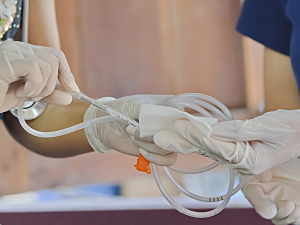Current forms of continuous monitoring in the ICU have notable limitations. The results of chemistry analysis are often not reported back for hours. Repeated phlebotomy and intravenous access expose patients to a number of potential complications, particularly infections. Breath monitoring is limited to gaseous markers.
Giovanni Traverso, MD, PhD, MBBCH, a gastroenterologist and biomedical engineer in the Division of Gastroenterology, Hepatology and Endoscopy at Brigham and Women’s Hospital and MIT, Christoph Steiger, former postdoctoral fellow at MIT, and colleagues found in porcine models that gastric fluid (GF), accessible through an ordinary nasogastric tube, contains many of the biomarkers associated with diseases treated in critical care settings. GF monitoring might even improve response times of clinical care teams compared with turnaround after standard laboratory blood testing, they say in Advanced Science.
Qualitative Biomarker Profiles
The researchers first analyzed serum and GF drawn from healthy pigs. 113 of 125 (94%) metabolic biomarkers found in porcine serum were also found in GF.
As a model of acute kidney failure, some pigs underwent renal artery ligation. GF levels of biomarkers were used to assess kidney function, including urea and creatinine, correlated well with serum levels.
Kinetic Biomarker Profiles
The team then used endoscopy in pigs to evaluate the kinetics of analyte levels in two acute settings:
- Acute kidney failure model—After renal artery ligation, urea, creatinine and phosphorous levels in serum and GF increased significantly from baseline over four hours. The levels also increased significantly compared with those in a control group
- Inducible stress model—After injection of adrenocorticotropic hormone, cortisol levels peaked within one hour in serum and three hours in GF. In serum the levels returned to baseline within three hours, but in GF they remained at 83% of the peak value after four hours
Proof of Concept
The researchers integrated a gas sensor into a commercially available nasogastric tube for continuous monitoring of acetone in pig stomachs. Acetone is already used to diagnose and monitor ketoacidosis arising from conditions such as diabetes and alcohol intoxication, and early clinical research suggests it can also facilitate early diagnosis of sepsis and guide nutritional support of critically ill patients.
After intravenous administration of acetone, gas chromatography-mass spectrometry showed comparable increases of acetone in GF and serum. Compared with serial phlebotomy every two to four hours, gastric sampling would provide more continuous insight into the patient’s response to treatment. That would allow more rapid titration of medication and perhaps faster resolution of ketosis.
The new sensor system also monitors temperature, pressure and humidity, with applications such as continuous body temperature monitoring for early detection of sepsis.
Future Directions
Nasogastric tubes are already widely used in ICUs for enteral feeding and bowel decompression. There are two possibilities for expanding their use to clinical monitoring:
- Aspiration of GF/gas for subsequent continuous ex vivo analysis, such as by selected-ion flow-tube mass spectrometry or ion mobility spectrometry
- Integration of sensors into nasogastric tubes for in situ measurement, as done in this study; this approach might rely on adapting recently developed ingestible and tethered sensors
It might also be possible to place tethered sensors in alternative locations (e.g., the rectum) or use untethered ingestible gastric resident systems. The latter might be feasible outside hospital settings.
